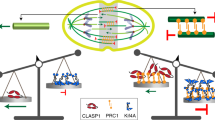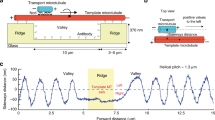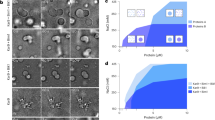Abstract
Short regions of overlap between ends of antiparallel microtubules are central elements within bipolar microtubule arrays. Although their formation requires motors1, recent in vitro studies demonstrated that stable overlaps cannot be generated by molecular motors alone. Motors either slide microtubules along each other until complete separation2,3,4 or, in the presence of opposing motors, generate oscillatory movements5,6,7. Here, we show that Ase1, a member of the conserved MAP65/PRC1 family of microtubule-bundling proteins, enables the formation of stable antiparallel overlaps through adaptive braking of Kinesin-14-driven microtubule–microtubule sliding. As overlapping microtubules start to slide apart, Ase1 molecules become compacted in the shrinking overlap and the sliding velocity gradually decreases in a dose-dependent manner. Compaction is driven by moving microtubule ends that act as barriers to Ase1 diffusion. Quantitative modelling showed that the molecular off-rate of Ase1 is sufficiently low to enable persistent overlap stabilization over tens of minutes. The finding of adaptive braking demonstrates that sliding can be slowed down locally to stabilize overlaps at the centre of bipolar arrays, whereas sliding proceeds elsewhere to enable network self-organization.
This is a preview of subscription content, access via your institution
Access options
Subscribe to this journal
Receive 12 print issues and online access
$209.00 per year
only $17.42 per issue
Buy this article
- Purchase on Springer Link
- Instant access to full article PDF
Prices may be subject to local taxes which are calculated during checkout




Similar content being viewed by others
References
Goshima, G. & Scholey, J. M. Control of mitotic spindle length. Annu. Rev. Cell Dev. Biol. 26, 21–57 (2010).
Braun, M., Drummond, D. R., Cross, R. A. & McAinsh, A. D. The kinesin-14 Klp2 organizes microtubules into parallel bundles by an ATP-dependent sorting mechanism. Nat. Cell Biol. 11, 724–730 (2009).
Fink, G. et al. The mitotic kinesin-14 Ncd drives directional microtubule–microtubule sliding. Nat. Cell Biol. 11, 717–723 (2009).
Kapitein, L. C. et al. The bipolar mitotic kinesin Eg5 moves on both microtubules that it crosslinks. Nature 435, 114–118 (2005).
Hentrich, C. & Surrey, T. Microtubule organization by the antagonistic mitotic motors kinesin-5 and kinesin-14. J. Cell Biol. 189, 465–480 (2010).
Tao, L. et al. A homotetrameric kinesin-5, KLP61F, bundles microtubules and antagonizes Ncd in motility assays. Curr. Biol. 16, 2293–2302 (2006).
Vale, R. D., Malik, F. & Brown, D. Directional instability of microtubule transport in the presence of kinesin and dynein, two opposite polarity motor proteins. J. Cell Biol. 119, 1589–1596 (1992).
Manning, A. L. & Compton, D. A. Structural and regulatory roles of nonmotor spindle proteins. Curr. Opin. Cell Biol. 20, 101–106 (2008).
Janson, M. E. et al. Crosslinkers and motors organize dynamic microtubules to form stable bipolar arrays in fission yeast. Cell 128, 357–368 (2007).
Peterman, E. J. G. & Scholey, J. M. Mitotic microtubule crosslinkers: insights from mechanistic studies. Curr. Biol. 19, R1089–R1094 (2009).
Loiodice, I. et al. Ase1p organizes antiparallel microtubule arrays during interphase and mitosis in fission yeast. Mol. Biol. Cell 16, 1756–1768 (2005).
Mollinari, C. et al. PRC1 is a microtubule binding and bundling protein essential to maintain the mitotic spindle midzone. J. Cell Biol. 157, 1175–1186 (2002).
Schuyler, S., Liu, J. & Pellman, D. The molecular function of Ase1p: evidence for a MAP-dependent midzone-specific spindle matrix. Microtubule-associated proteins. J. Cell Biol. 160, 517–528 (2003).
Yamashita, A., Sato, M., Fujita, A., Yamamoto, M. & Toda, T. The roles of fission yeast ase1 in mitotic cell division, meiotic nuclear oscillation, and cytokinesis checkpoint signaling. Mol. Biol. Cell 16, 1378–1395 (2005).
Khmelinskii, A., Roostalu, J., Roque, H., Antony, C. & Schiebel, E. Phosphorylation-dependent protein interactions at the spindle midzone mediate cell cycle regulation of spindle elongation. Dev. Cell 17, 244–256 (2009).
Fu, C. et al. Phospho-regulated interaction between kinesin-6 Klp9p and microtubule bundler Ase1p promotes spindle elongation. Dev. Cell 17, 257–267 (2009).
Kapitein, L. C. et al. Microtubule-driven multimerization recruits ase1p onto overlapping microtubules. Curr. Biol. 18, 1713–1717 (2008).
Gestaut, D. R. et al. Phosphoregulation and depolymerization-driven movement of the Dam1 complex do not require ring formation. Nat. Cell Biol. 10, 407–414 (2008).
Powers, A. F. et al. The Ndc80 kinetochore complex forms load-bearing attachments to dynamic microtubule tips via biased diffusion. Cell 136, 865–875 (2009).
Gardner, M. K. & Odde, D. J. Dam1 complexes go it alone on disassembling microtubules. Nat. Cell Biol. 10, 379–381 (2008).
Gruneberg, U. et al. KIF14 and citron kinase act together to promote efficient cytokinesis. J. Cell Biol. 172, 363–372 (2006).
Subramanian, R. et al. Insights into antiparallel microtubule crosslinking by PRC1, a conserved nonmotor microtubule binding protein. Cell 142, 433–443 (2010).
Bormuth, V., Varga, V., Howard, J. & Schäffer, E. Protein friction limits diffusive and directed movements of kinesin motors on microtubules. Science 325, 870–873 (2009).
Burbank, K. S., Mitchison, T. J. & Fisher, D. S. Slide-and-cluster models for spindle assembly. Curr. Biol. 17, 1373–1383 (2007).
Loughlin, R., Heald, R. & Nédélec, F. A computational model predicts Xenopus meiotic spindle organization. J. Cell Biol. 191, 1239–1249 (2010).
Smertenko, A. P. et al. The C-terminal variable region specifies the dynamic properties of Arabidopsis microtubule-associated protein MAP65 isotypes. Plant Cell 20, 3346–3358 (2008).
Zhu, C., Lau, E., Schwarzenbacher, R., Bossy-Wetzel, E. & Jiang, W. Spatiotemporal control of spindle midzone formation by PRC1 in human cells. Proc. Natl Acad. Sci. USA 103, 6196–6201 (2006).
Bratman, S. V. & Chang, F. Stabilization of overlapping microtubules by fission yeast CLASP. Dev. Cell 13, 812–827 (2007).
Bieling, P., Telley, I. A. & Surrey, T. A minimal midzone protein module controls formation and length of antiparallel microtubule overlaps. Cell 142, 420–432 (2010).
Ruhnow, F., Zwicker, D. & Diez, S. Tracking single particles and elongated filaments with nanometer precision. Biophys. J. 100, 2820–2828 (2011).
Pollard, T. D. A guide to simple and informative binding assays. Mol. Biol. Cell 21, 4061–4067 (2010).
Acknowledgements
We thank C. Bräuer for technical assistance; J. Teapal and T. Toda for yeast strains; and R. Schneider, M. Zanic, M. Gardner, J. Howard and B. Mulder for discussions. M.B. and S.D. acknowledge support from the European Research Council (ERC starting grant); G.F. from Boehringer Ingelheim Fonds; S.D. from the Deutsche Forschungsgemeinschaft (DFG Heisenberg Programme); and M.E.J. from the Division for Earth and Life Sciences (ALW) with financial aid from the Netherlands Organization for Scientific Research (NWO).
Author information
Authors and Affiliations
Contributions
M.B., Z.L., G.F., S.D. and M.E.J. designed the experiments; M.B., Z.L. and G.F. carried out the experiments; M.B., Z.L., G.F. and F.R. analysed the data; Z.L. and M.E.J. developed the model; M.B., Z.L., M.E.J. and S.D. wrote the manuscript; M.E.J. and S.D. initiated the research and supervised the work. All authors discussed the results and commented on the manuscript.
Corresponding authors
Ethics declarations
Competing interests
The authors declare no competing financial interests.
Supplementary information
Supplementary Information
Supplementary Information (PDF 1157 kb)
Supplementary Movie 1
Supplementary Information (MOV 66 kb)
Supplementary Movie 2
Supplementary Information (MOV 42 kb)
Supplementary Movie 3
Supplementary Information (MOV 444 kb)
Supplementary Movie 4
Supplementary Information (MOV 1213 kb)
Supplementary Movie 5
Supplementary Information (MOV 72 kb)
Rights and permissions
About this article
Cite this article
Braun, M., Lansky, Z., Fink, G. et al. Adaptive braking by Ase1 prevents overlapping microtubules from sliding completely apart. Nat Cell Biol 13, 1259–1264 (2011). https://doi.org/10.1038/ncb2323
Received:
Accepted:
Published:
Issue Date:
DOI: https://doi.org/10.1038/ncb2323
This article is cited by
-
Myosin II Adjusts Motility Properties and Regulates Force Production Based on Motor Environment
Cellular and Molecular Bioengineering (2022)
-
Kinetically distinct phases of tau on microtubules regulate kinesin motors and severing enzymes
Nature Cell Biology (2019)
-
Diffusive tail anchorage determines velocity and force produced by kinesin-14 between crosslinked microtubules
Nature Communications (2018)
-
Changes in microtubule overlap length regulate kinesin-14-driven microtubule sliding
Nature Chemical Biology (2017)
-
Kinesin-5-independent mitotic spindle assembly requires the antiparallel microtubule crosslinker Ase1 in fission yeast
Nature Communications (2017)



